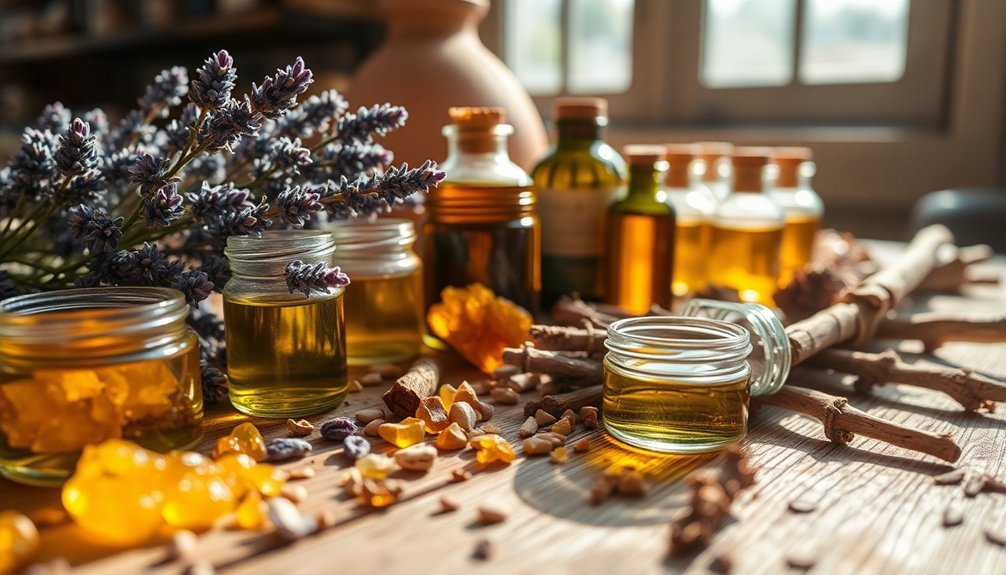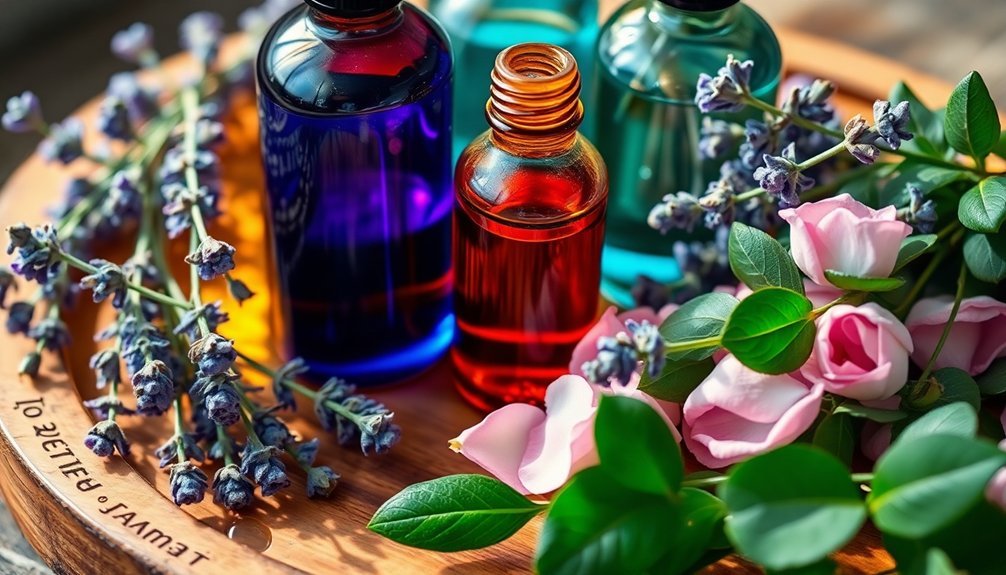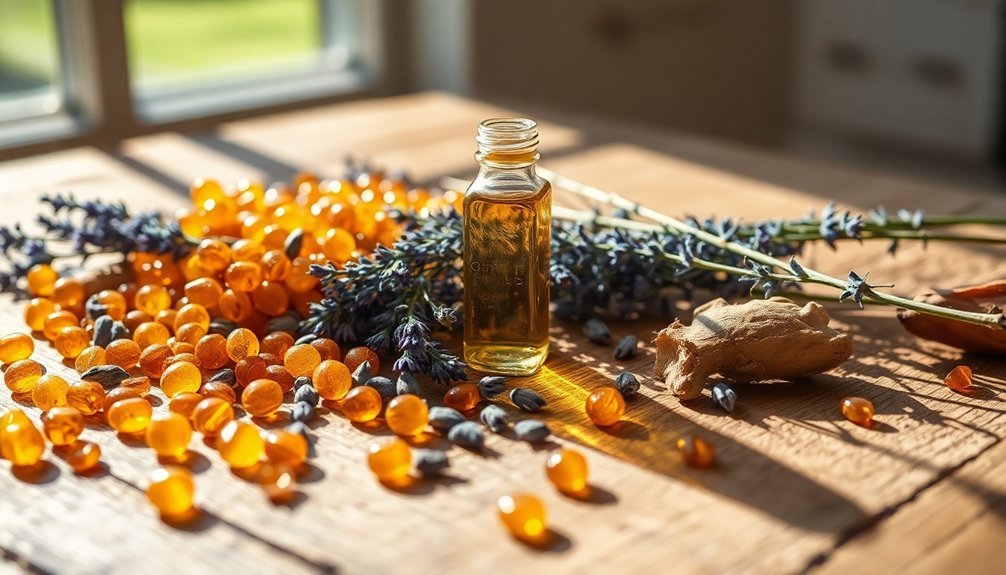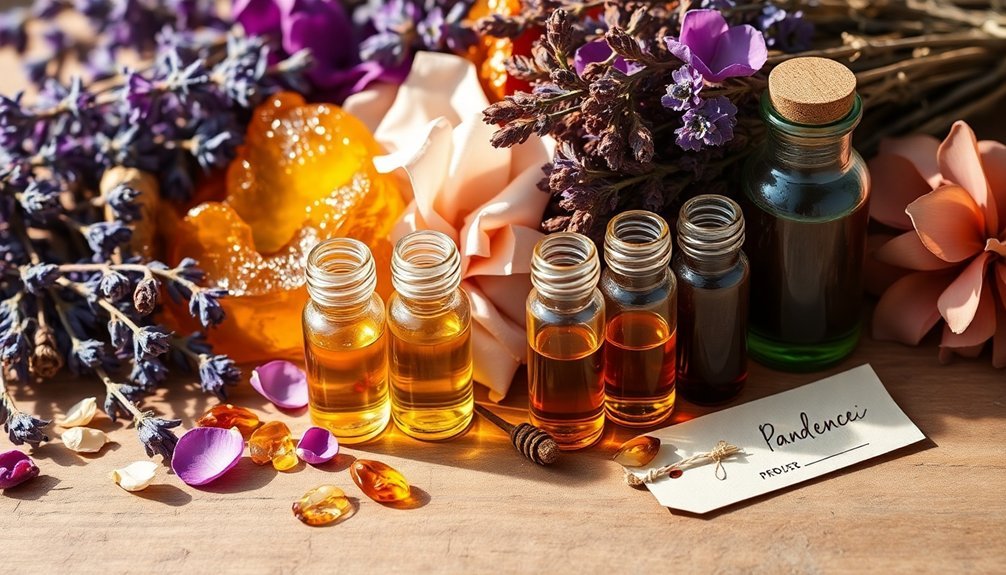Natural fixatives transform your homemade perfumes from fleeting scents into long-lasting fragrances. You'll find powerful staying power in vanilla bean absolute, patchouli, vetiver, frankincense, myrrh, benzoin, and labdanum – each adding unique depth while anchoring your blend. Use these fixatives at 3-5% concentration in your base notes, and combine them with complementary essential oils for maximum effect. Discover how these seven fixatives can elevate your perfume-making journey to professional levels.
What Are Natural Fixatives and Why They Matter

When creating your own perfume, natural fixatives serve as the unsung heroes that give your fragrance staying power and depth.
These substances, derived from plants, resins, and animal sources, work to stabilize your perfume's scent and prevent quick evaporation.
You'll find natural fixatives like benzoin, myrrh, amber, and sandalwood not only enhance your fragrance's longevity but also add sophisticated complexity to your creation. The careful selection of fixatives helps balance all notes for a harmonious fragrance experience.
They're essential in balancing the different notes of your perfume, ensuring lighter scents don't disappear too quickly.
By incorporating these fixatives, you'll achieve better diffusion across your skin while maintaining the integrity of your original aroma.
The best part? Natural fixatives contribute their own rich aromas to your perfume, making it more rounded and professionally crafted while preserving its character over time.
Vanilla Bean: The Sweet Secret to Lasting Scents
Among nature's most beloved fixatives, vanilla bean stands as a cornerstone in perfumery for its remarkable ability to anchor and enhance fragrances.
You'll find this versatile ingredient particularly effective in extending the life of your homemade perfumes, as it helps slow down the evaporation of volatile compounds.
When you're working with vanilla, you'll want to use it at 3-5% concentration in your base notes. As the second most expensive spice in the world after saffron, a little goes a long way in your formulations.
While Madagascar vanilla offers creamy sweetness, Tahitian vanilla provides darker, more complex undertones.
You can't extract vanilla as an essential oil, so you'll need to work with absolutes created through CO2 or solvent extraction.
For best results, blend your vanilla absolute with complementary fixatives like sandalwood or vetiver, as vanilla alone doesn't provide enough tenacity to sustain your fragrance throughout the day.
Essential Oils With Fixative Properties

You'll find that essential oils with fixative properties can dramatically extend your perfume's longevity while adding rich base notes to your blend.
These low volatility substances help stabilize and anchor your fragrance composition naturally, making them an excellent alternative to synthetic options.
Patchouli, vetiver, and sandalwood stand out as particularly effective fixatives, working to slow down the evaporation of more volatile top notes in your formulation.
When choosing fixative oils for your homemade perfumes, consider combining complementary scents like frankincense with cedarwood or patchouli with sandalwood to create stable, long-lasting fragrances.
Understanding Fixative Oil Benefits
Essential oils with fixative properties serve as natural anchors in homemade perfumes, helping to stabilize volatile compounds and extend a fragrance's longevity.
When you use fixative essential oils like patchouli, vetiver, or sandalwood, you'll notice they markedly slow down the evaporation of more delicate scent molecules, ensuring your perfume lasts longer on your skin.
These oils don't just extend wear time – they also enhance your perfume's complexity by adding depth and richness to the overall composition.
They work harmoniously with your body chemistry while stabilizing other fragrance notes, creating a balanced and consistent scent profile throughout the day.
You'll find that fixative oils like frankincense and cedarwood naturally integrate with other ingredients, maintaining the intended aromatic balance without introducing synthetic elements.
Choosing Compatible Essential Oils
Building on the foundation of fixative benefits, selecting the right combination of oils with anchoring properties can make or break your homemade perfume.
When choosing essential oils, you'll want to contemplate patchouli and vetiver as your primary fixatives, as they're known for their exceptional ability to anchor lighter scents.
Sandalwood and myrrh are versatile options that'll work well with floral notes like violet, rose, and lavender.
If you're looking for a piney undertone, frankincense is an excellent choice that doubles as a natural fixative.
Remember that these oils don't just anchor your fragrance – they contribute their own unique scents to your final composition.
You'll need to balance their aromatic profiles with your desired top and middle notes while contemplating how they'll interact with your skin chemistry.
Top Fixative Oil Combinations
The three most powerful fixative oil combinations merge the grounding qualities of multiple base notes for exceptional longevity.
You'll find remarkable staying power by combining vanilla with patchouli, creating a perfect balance between sweet and earthy elements.
For a more sophisticated blend, pair sandalwood with frankincense to achieve a warm, resinous foundation that's ideal for anchoring floral compositions.
When you're crafting woodier fragrances, try blending vetiver with myrrh. This combination delivers a deep, smoky character while ensuring your scent stays put throughout the day.
Each of these pairings works synergistically – the fixative properties of one oil enhance those of the other, resulting in a more stable and long-lasting fragrance that won't fade quickly on your skin.
Plant-Based Resins for Enhanced Longevity
Plant-based resins, harvested through careful steam distillation or solvent extraction, offer potent fixative properties for your DIY perfumes.
When choosing between frankincense and myrrh, you'll find frankincense excels at stabilizing citrus notes while myrrh works better with woody bases at the recommended 3-5% concentration.
You can achieve ideal results by first dissolving your chosen resin in a carrier oil before gradually incorporating it into your perfume blend, allowing proper dispersion of the fixative compounds.
Understanding Resin Extraction Methods
Successfully extracting resins from plants requires both careful harvesting techniques and modern extraction methods to achieve ideal results.
You'll need to start by selecting high-quality plants known for resin production, using sharp tools to make precise cuts without damaging the plant material.
Traditional methods like manual scraping and cold pressing can work, but you'll get better results with modern techniques. CO2 extraction and ultrasonic waves offer efficient, non-invasive ways to collect resin while minimizing plant damage.
If you're using incision methods, precision-engineered tools help maximize yield and reduce the risk of infection.
For the best outcomes, consider combining traditional and modern approaches. Steam distillation or solvent extraction with ethanol can effectively separate resins, while new technologies help trigger resin production in a controlled manner.
Frankincense Vs Myrrh Benefits
When comparing natural fixatives for homemade perfumes, frankincense and myrrh stand out as two powerhouse resins that offer remarkable longevity-enhancing properties.
You'll find that frankincense brings a sweeter, citrusy profile while helping to reduce inflammation and promote relaxation in your blends. It's particularly effective when used at 3-5% concentration to anchor lighter fragrance notes.
Myrrh, on the other hand, delivers an earthy, rich aroma with superior antiseptic and antimicrobial qualities. Its exceptional fixative capabilities slow down the evaporation of volatile compounds, making it ideal for extending your perfume's wear time.
Both resins work brilliantly when combined with other fixatives like benzoin or labdanum, and they're equally effective at balancing vapor pressures to maintain your intended scent profile throughout the day.
Best Blending Resin Techniques
Three essential techniques stand out for blending natural resins in homemade perfumes.
You'll want to start by combining multiple resins at a 3-5% concentration in your base notes – try mixing benzoin with labdanum for a rich, lasting foundation.
Next, layer your resins strategically with essential oils and plant extracts to create depth and maximize longevity.
- Use benzoin as your primary fixative for its sweet, vanilla notes and superior binding properties
- Combine labdanum and tolu balsam for a warm, amber-like depth
- Add storax to stabilize volatile compounds and enhance overall wear time
- Incorporate oud sparingly for complex woody undertones that evolve with your skin chemistry
Remember to store your blended resins properly in dark, cool conditions to maintain their potency and effectiveness in your perfume formulations.
Creating Your Base Note Foundation

Building a solid base note foundation is essential for creating long-lasting homemade perfumes that leave a memorable impression. Start by selecting two to three complementary base notes, focusing on natural fixatives like vanilla, sandalwood, or labdanum that'll help your fragrance last longer.
| Base Note | Best Paired With |
|---|---|
| Agarwood | Tobacco, Vanilla |
| Cedarwood | Cocoa, Balsam |
| Sandalwood | Frankincense, Myrrh |
When creating your foundation, maintain a 3-5% concentration of base notes in your overall blend. You'll want to test each combination on scent strips before finalizing your selection. Keep detailed notes of your experiments, including dates and specific measurements. Remember, the base notes you choose will interact with your skin chemistry, so what works for others might need adjusting for your unique composition.
Blending Techniques for Maximum Staying Power
Successfully blending a long-lasting natural perfume requires mastering the art of combining base, middle, and top notes with effective fixatives.
Start by selecting natural fixatives like benzoin, myrrh, or patchouli at 3-5% concentration to anchor your blend. Then, layer your notes following these essential proportions:
- Base notes (20-50%): Use rich ingredients like sandalwood or vanilla Madagascar to create depth
- Middle notes (30-40%): Add complexity with florals like jasmine or spices like cinnamon
- Top notes (20-40%): Incorporate citrus or mint oils for immediate impact
- Fixatives: Choose complementary options like frankincense for oriental scents or orrisroot for musky undertones
Remember to balance vapor pressures by experimenting with different fixative combinations.
This layering technique guarantees your fragrance maintains its character throughout the day while slowly releasing its complex bouquet of scents.
Storage and Application Tips for DIY Perfumes

To preserve your handcrafted perfumes and maximize their longevity, proper storage and application techniques are essential.
Store your perfumes in cool, dark places, ideally around 60 degrees, and keep them away from humid environments like bathrooms. Using protective containers and placing bottles on low-level shelves will shield them from light damage and prevent accidental spills.
For best application, start with moisturized skin and focus on pulse points, including the back of your neck.
You'll want to dab, not rub, the fragrance onto your skin, and consider applying it to your hair and clothing for extended wear. Always use unscented lotions or deodorants beforehand to avoid scent interference.
With higher concentrations of essential oils (around 25%) and proper storage conditions, you'll enjoy your DIY perfumes' fragrances much longer.
Frequently Asked Questions
Can Natural Fixatives Cause Allergic Reactions on Sensitive Skin?
Yes, you'll need to be careful as natural fixatives can trigger allergic reactions on sensitive skin, causing rashes, redness, and irritation. They often contain essential oils and plant extracts that are common allergens.
How Long Can Homemade Perfumes With Natural Fixatives Be Stored?
You can store your homemade perfumes for 6-12 months when properly kept in dark bottles and cool conditions. They'll start degrading after a year, so it's best to make smaller batches you'll use up.
Are Natural Fixatives More Expensive Than Synthetic Alternatives?
Yes, you'll find natural fixatives are typically more expensive than synthetic ones. They're costly due to limited availability, extensive processing requirements, and their origin from rare sources like specific plants or animal products.
Do Natural Fixatives Work Differently in Alcohol-Based Versus Oil-Based Perfumes?
Yes, natural fixatives work differently in each base. In oil perfumes, they blend seamlessly and release slowly, while in alcohol perfumes, they'll need stronger concentrations to combat the faster evaporation rate.
Can I Mix Different Types of Natural Fixatives Together?
Yes, you can mix different natural fixatives together! You'll find resins work well with essential oils, while vanilla complements benzoin beautifully. Just keep the total concentration between 3-5% in your blend.
In Summary
You've now got all the tools to create long-lasting natural perfumes that'll rival commercial fragrances. By incorporating these seven fixatives into your DIY blends, you'll reveal the secret to scents that stay with you throughout the day. Remember to store your creations properly in dark glass bottles and experiment with different combinations until you find your signature blend. Start mixing, and let your natural perfumes make a lasting impression.





Leave a Reply